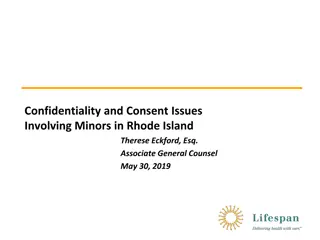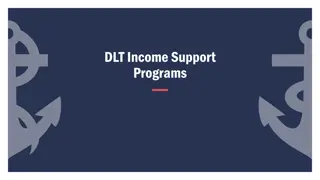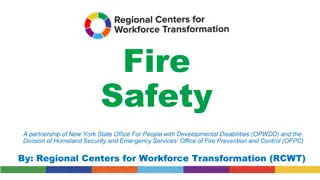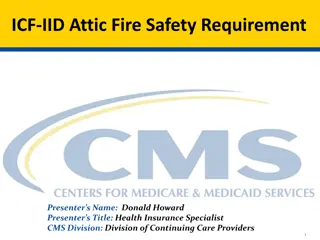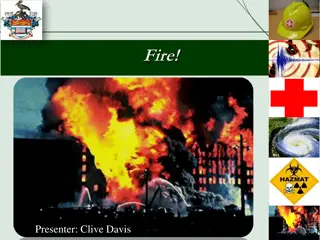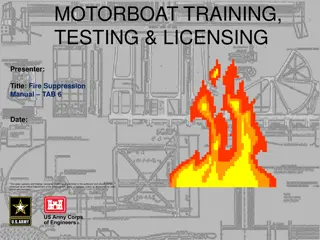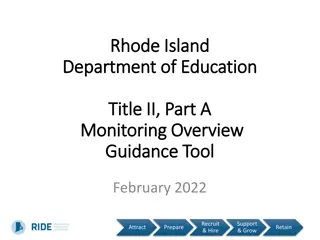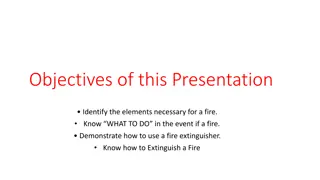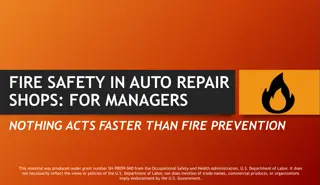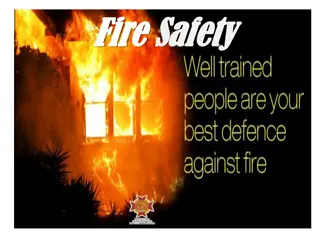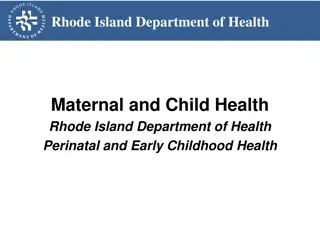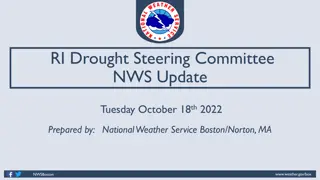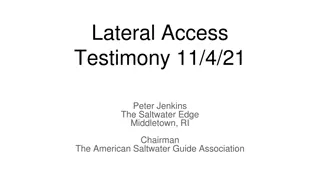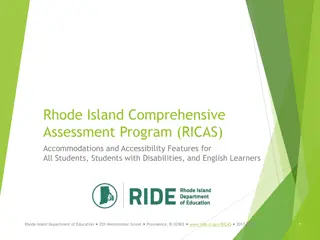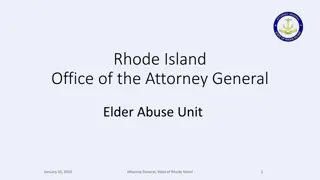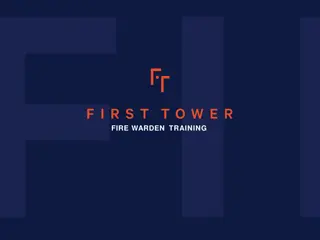Rhode Island Fire and Life Safety Code Residential Requirements
The Rhode Island Fire and Life Safety Code outlines regulations for different types of dwellings, including one- and two-family units, lodging and rooming houses, emergency shelters, hotels, dormitories, and apartments. The code defines occupancy classifications, such as one- and two-family dwellings and lodging or rooming houses, based on the number of occupants and services provided. It also provides guidance on determining allowable guests and regulating properties accordingly. Annex materials assist in the classification of occupancy, with specific criteria for family units and lodging establishments.
Download Presentation

Please find below an Image/Link to download the presentation.
The content on the website is provided AS IS for your information and personal use only. It may not be sold, licensed, or shared on other websites without obtaining consent from the author. Download presentation by click this link. If you encounter any issues during the download, it is possible that the publisher has removed the file from their server.
E N D
Presentation Transcript
SHORT TERM RENTALS June 3, 2024 Robert Dufault Kevin Tuthill
Rhode Island Fire and Life Safety Code Residential Code Requirements 2018 NFPA 1 Fire Safety Code with R.I. Amendments 2018 NFPA 101 Life Safety Code with R.I. Amendments Chapter 24 One and Two Family Dwellings Chapter 25 Three Family Dwellings Chapter 26 Lodging and Rooming Chapter 27 Emergency Shelter Chapter 28 Hotels and Dormitories Chapter 30 Apartments
Current Life Safety Code Definitions Determine the Occupancy By It s Use One- and Two-Family Dwelling Unit. A building that contains not more than two dwelling units, each dwelling unit occupied by members of a single family with not more than three outsiders, if any, accommodated in rented rooms. Lodging or Rooming House. A building or portion thereof that does not qualify as a one- or two- family dwelling, that provides sleeping accommodations for a total of 16 or fewer people on a transient or permanent basis, without personal care services, with or without meals, but without separate cooking facilities for individual occupants.
Annex Material (Enforceable in R.I., assists in the determination of the occupancy classification) A.6.1.8.1.1 One- and Two-Family Dwelling Unit. The application statement of 24.1.1.1 limits each dwelling unit to being occupied by members of a single family with not more than three outsiders. The Code does not define the term family. The definition of family is subject to federal, state, and local regulations and might not be restricted to a person or a couple (two people) and their children. The following examples aid in differentiating between a single-family dwelling and a lodging or rooming house:
One-and-Two Family Annex A.24.1.1.2 An individual or a couple (two people) who rent a house from a landlord and then sublease space for up to three individuals should be considered a family renting to a maximum of three outsiders, and the house should be regulated as a single-family dwelling in accordance with Chapter 24. (we are currently using this guidance to determine allowable guests) A house rented from a landlord by an individual or a couple (two people) in which space is subleased to 4 or more individuals, but not more than 16, should be considered and regulated as a lodging or rooming house in accordance with Chapter 26. A residential building that is occupied by 4 or more individuals, but not more than 16, each renting from a landlord, without separate cooking facilities, should be considered and regulated as a lodging or rooming house in accordance with Chapter 26.
One-and-Two Family Annex Cont. A group of nonrelatives living together in a nontraditional group can be the functional equivalent of a more traditional family unit. The factors that must be considered by the authority having jurisdiction are whether the group shares the entire house other than individual bedrooms, lives, cooks, and functions together as a single housekeeping unit and is primarily nontransient.
One and Two Family Requirements Smoke and carbon monoxide requirements depend upon the year the building was built. Prior to 1976 the requirements are 1 smoke on every level and outside the bedroom door (within a reasonable distance). Different levels of protection in different years up until the current 2018 Edition of RI Fire and Life Safety Code and 2019 Edition of NFPA 72 (Fire Alarm Code). Built Prior to 1976 (A majority of the houses in RI) Battery Units allowed Only required on each level and in the hall outside bedrooms
Determine The Occupancy This is important because if we as the AHJ classify the occupancy incorrectly then where would the liability lie? The application itself tells you the occupancy, the number of guests and that it is going to be transient. If it is determined that the occupancy is no longer being used as a One and Two Family Dwelling and its classification is Lodging and Rooming, we as the AHJ have the right of entry to inspect under the fire code. We will and I have had the support of the State Fire Marshals Office and Fire Board of Appeal and Review. This is the Code and level of protection the State of Rhode Island decided was appropriate. The Administration of the City of Newport, the solicitors office and the Chief all were supportive of the enforcement.
Lodging and Rooming Subclassifications Lodging and Rooming Bed and Breakfast between 4 and 6 guests Bed and Breakfast between 7 and 16 guests Congregate Living Facility between 4 and 6 guests Congregate Living Facility between 7 and 16 guests
Current Regulations What people want to know! Who needs a Commercial Fire Alarm System? All Lodging and Rooming Occupancies Hotels New and Existing Exempt Bed and Breakfasts and Congregate Living Facilities with a capacity under 7 guests Who needs a sprinkler system? Any Lodging and Rooming Occupancy built or converted after June 29,1990. High Rises and New Hotels Exempt All Bed and Breakfast and Congregate Living Facilities
Lodging and Rooming Requirements This is how the code tells us what occupancy these short term rentals are and the requirements for it. Several of us in the southern part of the state are working on a proposal to present to the State Fire Marshals Office and to the Rhode Island Association of Fire Marshals for smaller size structures and fewer occupants to get relief from some of the more stringent requirements for Lodging and Rooming Occupancies.
Narragansett 1297 Listings found on internet rental platforms 1085 Unique units represented 96% are single family homes Only 4% are multi family 99% list the entire home 1% listed as partial home Average cost per night $350
Narragansett Continued Personal Experience as the Narragansett Fire Marshal I have identified, documented, and brought approximately 75 illegal bedrooms in to compliance over a 5 year period I have facilitated the replacement of hundreds of outdated or inappropriate smoke and co alarms 25 of 262 smoke/co inspections failed in 2023 or 9.5% These are requested inspections with real estate professionals who know the code Narragansett had 21 structure fires in 2023 9 of them occurred in registered rentals 7 of the 9 occurred in STR s (Narragansett has ~1100 STR s and 9857 housing units per the 2022 census) Even though STR s only account for 1/10thof the housing units they accounted for 33% of fires
What we Need! A robust STR definition that applies to most if not all short term rental units A clear line between 1 and 2 family units, Bed and Breakfasts, Lodging and Rooming Houses, Congregate Family Living Units, and Short Term Rental Units Relief from the current regulations for STR units that meet consensus criteria X Square Feet in Size X Stories in height X number of guests The X s are what we need a diverse working group to decide!!
What we Need Continued Funding to administer and enforce these codes Staffing Technology Permitting and Documentation Inspection Code Requirements for units that meet the STR definition NFPA and RI Proposed See Slides 10-12
STR DEFINITIONS (working options) NFPA - 3.3.XX Short-Term Rental Housing Unit (proposed) An entire dwelling unit, that is advertised or offered to the public as a place regularly rented to an individual tenant, a family or multiple tenants under a single lease for periods of less than 30 consecutive days. Rhode Island - Title: Transient Rental House (proposed) A Transient Rental House is defined as a building or part thereof that contains sleeping rooms where residents share the entire structure and live, cook and function together as a single housekeeping unit. Every Transient Rental House must further have originated as a private residence, shall be limited to no more than two (2) stories in height above the level of exit discharge and shall not exceed two thousand five hundred (2,500) square feet of finished living area for rent. Transient rental houses consist of contractual arrangement for the occupation of a dwelling unit or dwelling units by an individual tenant, a family or multiple tenants under a single lease, for residential and/or dwelling purposes, for a period of less than thirty (30) consecutive nights.
NFPA STR DEFINITION ANNEX (Draft) A.3.3.XX Short-Term Rental Housing Unit. Where a dwelling unit is rented to occupants for a period of less than one month (e.g., nightly, weekly), the occupants are considered transient and are expected to have less familiarity with their surroundings than occupants who rent a property for a month or longer. The requirements of Section 24.6 are intended to bridge the gap between one- and two-family dwellings and lodging or rooming houses for dwelling units utilized for short- term rental housing. Where individual sleeping rooms are rented out, the property might be a lodging or rooming house if the dwelling unit is occupied by a family and more than three outsiders in rented rooms, or if it is occupied only by renters of individual sleeping rooms with shared common space. Where a dwelling unit is wholly rented and occupied by a group, it is expected that the group members will have a higher degree of awareness of the activities of other group members than occupants of individually rented sleeping rooms. This increased awareness generally lowers the life safety risk and the more rigorous requirements applicable to lodging or rooming houses or hotels and dormitories should not be warranted.
NFPA Code (DRAFT) 24.6 Short-Term Rental Unit 24.6.1 General 24.6.1.1 The provisions of Chapter 24 and this section shall apply to Short-Term Rental Housing Unit. (Smoke and Co Alarms per current code) 24.6.1.2 The provisions of Chapter 26 shall apply to Short-term Rental Housing Units where there are 10 or more sleeping accommodations. 24.6.1.2 Buildings shall have an approved, legible address number placed in a position visible from the street or road fronting the property in accordance with NFPA 1. 24.6.1.3 Outdoor fires, open fires, and cooking equipment shall be in compliance with NFPA 1. 24.6.2 Occupancy Safety 24.6.2.1* A floor diagram reflecting the actual floor arrangement, exit locations, room identification, and fire extinguisher locations shall be posted in a location and manner acceptable to the AHJ. A.24.6.2.1 A sample floor diagram is shown in figure A.24.6.2.1: 24.6.2.2* Upon request the floorplan required in 24.6.2.1 shall be made available to the AHJ upon request.
NFPA Code (Draft) Continued A.24.6.2.2 A safety plan is a useful tool for both guests and AHJ s to verify the safety of the location. The safety plan for a short-term rental unit should include the following: 1. Name and contact information of responsible party. 2. The procedure for a guest to report an emergency and the means of communicating that procedure to guests. 3. A graphic illustration of the full floor plan of the dwelling unit or sleeping unit with a short-term rental unit that includes the following: (a) The location of each sleeping space. (b) Two escape paths for each sleeping space, including the path to the nearest outside exit door and to a designated emergency escape and rescue opening for the sleeping space. (c) The location of portable fire extinguishers, smoke alarms, carbon monoxide alarms, and emergency escape ladders if provided. (d) Location of fuel-fired equipment and appliances. 4. (4) Safety equipment records, including the following: (a) Manufacturing date of each smoke alarm, as marked on the back of the alarm. (b) Manufacturing date of each carbon monoxide alarm, as marked on the back of the alarm. (c) Manufacturing date of portable fire extinguishers.
Rhode Island Code (DRAFT Proposal) *This stems from a small working group and will still need to be reviewed by the State Fire Marshal (Add) 26.X All Transient Rental Houses require smoke and carbon monoxide alarms installed in accordance with the regulations and standards of Chapter 24. There shall be approved detection in each sleeping room. (Add) 26.X All Transient Rental Houses with a capacity of between one (1) and five (5) residents shall meet the following requirements for this occupancy: 1. Interconnected smoke alarms and carbon monoxide alarms shall be installed in accordance with NFPA 72. 2. A Fire Extinguisher installed on each level in a location along the path of egress or otherwise acceptable to the AHJ 3. An evacuation plan, containing alternative emergency egress routes, shall be presented to the local fire authority for approval, and upon approval shall be posted in every sleeping room. (Add) 26.X All Transient Rental Houses with a capacity of between six (6) and ten (10) residents shall meet the following requirements for this occupancy: 1. A Monitored Residential Fire Alarm System in accordance with NFPA 72 Chapter 29 2. A Fire Extinguisher installed on each level in a location along the path of egress or otherwise acceptable to the AHJ 3. Existing doors shall be equipped with self-closing hinges in order to limit the movement of smoke during a fire 4. Emergency lighting shall be installed in any corridors and/or stairways greater than eight feet (10 ) in length. 6. An evacuation plan, containing alternative emergency egress routes, shall be presented to the local fire authority for approval, and upon approval shall be posted in every sleeping room. Any building complying with the above Transient Rental Houses guidelines, with a capacity in excess of ten (10) residents shall comply with the requirements for a lodging and Rooming occupancy as outlined in the provisions of Chapter 26 of the Rhode Island Life Safety Code.
Other Occupancies Hotels and Bed and Breakfasts This is a very broad overview Hotels Sprinkler required Commercial fire alarm required Smoke alarms required in each room Protected stairs required Self closing doors required Exit signs required Bed and Breakfast Requires the owner or manager to reside in the residence 24/7 4-6 guests interconnected smoke and co alarms, exit signs, evac plan 7-16 guests Fire Alarm system, solid core doors, exit signs, evac plan,
General Safety Requirements All Electrical work must meet NFPA 70 Extension cords can not be used as permanent wiring Appliances must be UL or ETL Listed They must be plugged directly in to an outlet First Aid Kits Are not currently required by fire code Air B and B does provide recommendations that each house have a red cross approved kit
Our Recommendations Create a Statewide STR definition Organize a working group of stakeholders to discuss and refine code requirements The RI Fire Board of Appeal and Review is a great example of a stakeholder group i.e. engineers, fire professionals, members of the public, code consultants, attorneys etc. Create clear and concise code requirements that owners, guests, and fire code officials will understand Provide relief from current regulations that balances safety and property rights


